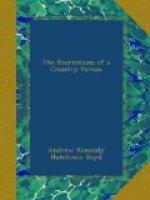In sailing down the Frith, one gets no just idea of the richness and beauty of its shores. We have said that a little strip of fine soil,—in some places only fifty or sixty yards in breadth,—runs like a ribbon, occasionally broadening out to three or four times that extent, along the sea-margin; beyond this ribbon of ground come the wild moor and mountain. In sailing down the Frith, our eye is caught by the large expanse of moorland, and we do not give due importance to the rich strip which bounds it, like an edging of gold lace (to use King James’s comparison) round a russet petticoat. When we land we understand things better. We find next the sea, at almost any point along the Frith, the turnpike road, generally nearly level, and beautifully smooth. Here and there, in the places of older date, we find quite a street of contiguous houses; but the general rule is of detached dwellings of all grades, from the humblest cottage to the most luxurious villa. At considerable intervals, there are residences of a much higher class than even this last, whose grounds stretch for long distances along the shore. Such places are Ardgovvan, Kelly, Skelmorlie Castle, and Kelburne, on the Ayrshire side; and on the other shore of the Frith, Roseneath Castle, Toward Castle, and Mountstuart. [Footnote: Ardgowan, residence of Sir Michael Shaw Stewart; Kelly, Mr. Scott; Skelmorlie, the Earl of Eglinton; Kelburne, the Earl of Glasgow; Roseneath, the Duke of Argyle; Toward, Mr. Kirkwall Finlay Mountstuart, the Marquis of Bute.] And of dwellings of a less ambitious standing than these really grand abodes, yet of a mark much above that suggested by the word villa, we may name the very showy house of Mr. Napier, the eminent maker of marine steam-engines, on the Gareloch, a building in the Saracenic style, which cost we are afraid to say how many thousand pounds; the finely-placed castle of Wemyss, built from the design of Billings; and the very striking piece of baronial architecture called Knock Castle, the residence of Mr. Steel, a wealthy shipbuilder of Greenock. The houses along the Frith are, in Scotch fashion, built exclusively of stone, which is obtained with great facility. Along the Ayrshire coast, the warm-looking red sandstone of the district is to be had everywhere, almost on the surface. One sometimes sees a house rising, the stone being taken from a deep quarry close to it: the same crane often serving to lift a block from the quarry, and to place it in its permanent position upon the advancing wall. We have said how rich is vegetation all along the Frith, until we reach the sandy downs from Ardrossan to Ayr. All evergreens grow with great rapidity: ivy covers dead walls very soon. To understand in what luxuriance vegetable life may be maintained close to the sea-margin, one must walk along the road which leads from the West Bay at Dunoon towards Toward. We never saw trees so covered with honeysuckle; and fuchsias a dozen feet in height are quite common.




